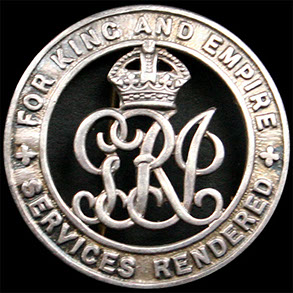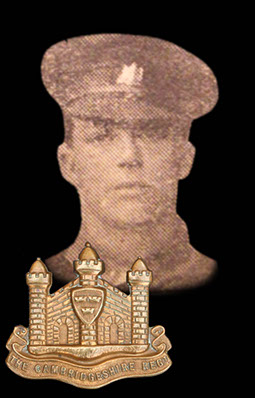For King and Empire – The Silver War Badge & L/Cpl H.H. Greaves
In September 1916 it was announced that a small silver lapel badge was to be issued, the official Army order states:
His Majesty the King has approved the issue of a silver war badge to officers and men of the British, Indian, and Overseas Forces, who have served at home or abroad since the 4th August, 1914, and who on account of age, or physical infirmity arising from wounds or sickness caused by military service have, in the case of officers, retired or relinquished their commissions, or, in the case of men, been discharged from the Army.
The badge was circular in form with the words “For King and Empire – Services Rendered” around the edge. In the centre was the crown and cypher for King George V. Many people now call it a Silver Wound Badge or just Wound Badge, however this is incorrect as it was also issued for reasons other than wounds and the official title is Silver War Badge. To collectors and militaria dealers it is usually called a SWB. More information on those discharged due to sickness and ill health can be found by clicking here.
Each badge was issued to a specific man and while it is not named it has a unique serial number on the back, this can be cross referenced and the recipient identified. Over one million were issued in total and approximately one thousand of these were to men who had served at some point with the Cambs. Behind each of these little badges there is a story…
Silver War Badge Number 335204
Herbert Harold Greaves was born in the summer of 1893 in Ely and grew up at the family home in the Annesdale area of the city. His father was a platelayer for the GER and his older brothers also started work on the railway when they were old enough. After leaving school Herbert started work in one of the other key industries in that area and became a bottle washer at one of the big breweries.
In the summer of 1913 Herbert married Lily May Wilden at Ely and the young couple moved to Cambridge Road, Ely. With the outbreak of war the following year it was not long before Herbert volunteered and on the 4th September he attested with the Cambridgeshire Regiment. He was given the number 2344 and quickly was posted to Ely and District Squad for training. He initially remained in the UK when the 1/1st went to France in February 1915, serving instead with the 2/1st and then later the 3/1st Battalion.
As the losses in the 1/1st increased during the summer of 1916 the frequency of the much needed replacement drafts from the UK soared. In December 1916 alone nearly 300 men were sent over from the Cambs Reserve Battalions, Herbert was one of these men and he joined the 1/1st in early January 1917. For most of the time he was with the Cambs overseas they were around the Ypres Salient and activity and fighting increased with the build up to the summer offensive, now known as Passchendaele.
Herbert survived the horrors of the 31st July 1917, the first day of Passchendaele, when the Battalion took part in the bitter fighting around St Julien. In September the Cambs moved over to the East of Ypres and started preparations for another attack. On the 23rd September the Battalion was in the front line in the Shrewsbury Forest area (an area many would have known well from 1915). Various reconnaissance operations were carried out and the Cambs had 14 men wounded on that day. One of these was Herbert who was wounded in the chest and back. It soon became apparent that these wounds were very serious and that there was internal damage to both his lungs and spine. He was moved to the 11th Casualty Clearing Station and while there a nurse wrote to his wife to inform her of the situation:
I am afraid his spine is injured and he cannot move his legs and has no feeling in them. Everything possible will be done for him and I hope things will not be as bad as they appear.
Another letter was sent by the Clearing Station’s Chaplain, who wrote:
The chest wound is going on alright and taking its course, though they are always serious owing to the lung injury. But the other has done some injury to the spine and he is paralysed in the lower part of the body. The last day or so there have been one or two signs that look as if the injury to the spine may get better but as soon as he can be sent home he will go to a special hospital for that. He will go as soon as the chest wound allows him to be moved. He is very good and patient… I think it is fairly certain that he will be able to be sent home all right – it is too early to say anything for certain yet about his final recovery.
Once back in the UK Herbert was taken to the King George Hospital in London and underwent treatment for his spinal wound. The severity and lasting damage meant that he was discharged from the Army on the 20th February 1918. He was issued the Silver War Badge number 335204.
For hundreds of thousands of those who were issued a "SWB" the damage, be it psychological, physical wounds, or sickness and poor health, remained with them for the rest of their lives. Herbert was amongst them and he was left paralysed from the waist down and his other injuries led to numerous other complications. He never recovered from the wounds he received at Shrewsbury Forest in September 1917 and sadly died at Adenbrooke’s Hospital on the 1st March 1924.

A Silver War Badge.

Herbert Greaves after he joined the Cambs.

This site went live on the 14th February 2015 to mark 100 years since the 1/1st Cambs went off to war.
WE WILL REMEMBER THEM
Email us: cambsregt@gmail.com
Copyright 2015, 2016, 2017, 2018, 2019 by Felix Jackson. The information and images on this site should not be reproduced without prior permission.